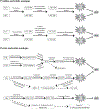Nucleotide Reverse Transcriptase Inhibitors: A Thorough Review, Present Status and Future Perspective as HIV Therapeutics
- PMID: 29165087
- PMCID: PMC7219633
- DOI: 10.2174/1570162X15666171120110145
Nucleotide Reverse Transcriptase Inhibitors: A Thorough Review, Present Status and Future Perspective as HIV Therapeutics
Abstract
Background: Human immunodeficiency virus type-1 (HIV-1) infection leads to acquired immunodeficiency syndrome (AIDS), a severe viral infection that has claimed approximately 658,507 lives in the US between the years 2010-2014. Antiretroviral (ARV) therapy has proven to inhibit HIV-1, but unlike other viral illness, not cure the infection.
Objective: Among various Food and Drug Administration (FDA)-approved ARVs, nucleoside/ nucleotide reverse transcriptase inhibitors (NRTIs) are most effective in limiting HIV-1 infection. This review focuses on NRTIs mechanism of action and metabolism.
Methods: A search of PubMed (1982-2016) was performed to capture relevant articles regarding NRTI pharmacology.
Results: The current classical NRTIs pharmacology for HIV-1 prevention and treatment are presented. Finally, various novel strategies are proposed to improve the efficacy of NRTIs, which will increase therapeutic efficiency of present-day HIV-1 prevention/treatment regimen.
Conclusion: Use of NRTIs will continue to be critical for successful treatment and prevention of HIV-1.
Keywords: AIDS; Antiretroviral drugs; HIV-1; NRTIs; antiretroviral therapy; nanomedicine.
Copyright© Bentham Science Publishers; For any queries, please email at epub@benthamscience.org.
Figures


Similar articles
-
Current insights and molecular docking studies of HIV-1 reverse transcriptase inhibitors.Chem Biol Drug Des. 2024 Jan;103(1):e14372. doi: 10.1111/cbdd.14372. Epub 2023 Oct 10. Chem Biol Drug Des. 2024. PMID: 37817296 Review.
-
Nucleoside inhibitors of human immunodeficiency virus type 1 reverse transcriptase.Curr Top Med Chem. 2004;4(9):895-919. doi: 10.2174/1568026043388484. Curr Top Med Chem. 2004. PMID: 15134548 Review.
-
The nucleoside reverse transcriptase inhibitors, nonnucleoside reverse transcriptase inhibitors, and protease inhibitors in the treatment of HIV infections (AIDS).Adv Pharmacol. 2013;67:317-58. doi: 10.1016/B978-0-12-405880-4.00009-3. Adv Pharmacol. 2013. PMID: 23886005 Review.
-
The development of anti-HIV-1 drugs.Yao Xue Xue Bao. 2010 Feb;45(2):165-76. Yao Xue Xue Bao. 2010. PMID: 21348415 Review.
-
Progress of bis(heteroaryl)piperazines (BHAPs) as non-nucleoside reverse transcriptase inhibitors (NNRTIs) against human immunodeficiency virus type 1 (HIV-1).Mini Rev Med Chem. 2010 Jan;10(1):62-72. doi: 10.2174/138955710791112578. Mini Rev Med Chem. 2010. PMID: 20380641 Review.
Cited by
-
Modeling of HIV-1 prophylactic efficacy and toxicity with islatravir shows non-superiority for oral dosing, but promise as a subcutaneous implant.CPT Pharmacometrics Syst Pharmacol. 2024 Oct;13(10):1693-1706. doi: 10.1002/psp4.13212. Epub 2024 Aug 20. CPT Pharmacometrics Syst Pharmacol. 2024. PMID: 39164932 Free PMC article.
-
A Critical Review of the Biochemical Mechanisms and Epigenetic Modifications in HIV- and Antiretroviral-Induced Metabolic Syndrome.Int J Mol Sci. 2021 Nov 6;22(21):12020. doi: 10.3390/ijms222112020. Int J Mol Sci. 2021. PMID: 34769448 Free PMC article. Review.
-
Discovery, SAR study and ADME properties of methyl 4-amino-3-cyano-1-(2-benzyloxyphenyl)-1H-pyrazole-5-carboxylate as an HIV-1 replication inhibitor.RSC Med Chem. 2020 Apr 27;11(5):577-582. doi: 10.1039/d0md00025f. eCollection 2020 May 1. RSC Med Chem. 2020. PMID: 33479659 Free PMC article.
-
Pharmacokinetic Outcomes of the Interactions of Antiretroviral Agents with Food and Supplements: A Systematic Review and Meta-Analysis.Nutrients. 2022 Jan 25;14(3):520. doi: 10.3390/nu14030520. Nutrients. 2022. PMID: 35276881 Free PMC article.
-
Enhanced Anti-Leukemic Activity of Platinum Lamivudine Compared To Lamivudine Through Differential Gene Regulation and DNA Groove Binding.Cell Biochem Biophys. 2025 Aug 8. doi: 10.1007/s12013-025-01855-7. Online ahead of print. Cell Biochem Biophys. 2025. PMID: 40779127 No abstract available.
References
-
- CDC. HIV in the United States: At A Glance Atlanta, GA, USA: MMWR; 2012. [updated June 1, 2017 Available from: http://www.cdc.gov/hiv/statistics/overview/ataglance.html.
-
- CDC. Diagnoses of HIV Infection in the United States and Dependent Areas, 2015. Atlanta, GA, USA: MMWR; 2015 [updated June 1, 2017 Available from: https://www.cdc.gov/hiv/pdf/library/reports/surveillance/cdc-hiv-surveil....
-
- Barre-Sinoussi F, Chermann JC, Rey F, Nugeyre MT, Chamaret S, Gruest J, et al. Isolation of a T-lymphotropic retrovirus from a patient at risk for acquired immune deficiency syndrome (AIDS). 1983. Rev Invest Clin. 2004; 56(2): 126–9. - PubMed
-
- Barre-Sinoussi F, Chermann JC, Rey F, Nugeyre MT, Chamaret S, Gruest J, et al. Isolation of a T-lymphotropic retrovirus from a patient at risk for acquired immune deficiency syndrome (AIDS). Science. 1983; 220(4599): 868–71. - PubMed
-
- Popovic M, Sarngadharan MG, Read E, Gallo RC. Detection, isolation, and continuous production of cytopathic retroviruses (HTLV-III) from patients with AIDS and pre-AIDS. Science. 1984; 224(4648): 497–500. - PubMed
Publication types
MeSH terms
Substances
Grants and funding
LinkOut - more resources
Full Text Sources
Other Literature Sources
Medical

